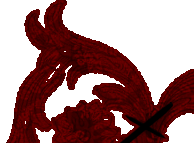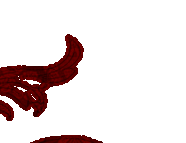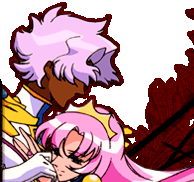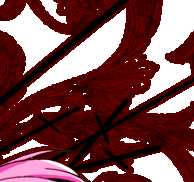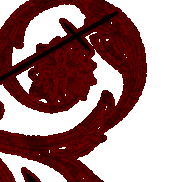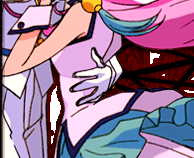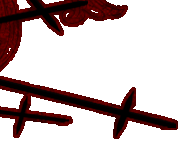
This analysis
was donated by Kayla Dunn. 
For Module Five’s Special Topic, I will be discussing (some of) the examples of exoticism that permeate Kunihiko Ikuhara’s Revolutionary Girl Utena, and how these items are (loosely) connected with the exoticism that is portrayed in Laurent Cantet’s Heading South (i.e., Vers Le Sud).
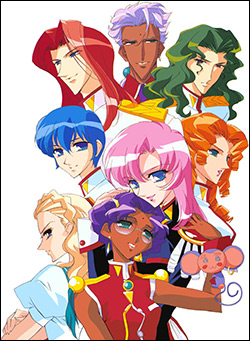 Within Kunihiko Ikuhara’s magnum opus, a menagerie of (literally and figuratively) colorful characters inhabit the prestigious Ohtori Academy, a school that (literally and figuratively) exists in its own reality. Of all the people that populate this place, the most interesting individuals are, without a doubt, Anthy Himemiya and Akio Ohtori, a pair of siblings that are shrouded in mystery. One indicator of their mysteriousness (and otherness) is, invariably, their exotic appearances, which, in turn, is derived from their (presumed) Indian heritage. Within Kunihiko Ikuhara’s magnum opus, a menagerie of (literally and figuratively) colorful characters inhabit the prestigious Ohtori Academy, a school that (literally and figuratively) exists in its own reality. Of all the people that populate this place, the most interesting individuals are, without a doubt, Anthy Himemiya and Akio Ohtori, a pair of siblings that are shrouded in mystery. One indicator of their mysteriousness (and otherness) is, invariably, their exotic appearances, which, in turn, is derived from their (presumed) Indian heritage.
As the image above implies, Akio and Anthy are (the only) members of the minority population within Ohtori Academy, whose other inhabitants are of Japanese descent. This, invariably, reflects the near-homogeneity of the Japanese nation, whose minority – i.e., non-Japanese - population composes less than 2% of the nation’s overall population (“Japan Demographics Profile 2018”). Now, despite (or, perhaps, because of) the Japanese nation’s near-homogeneity, the Japanese people – and, by extension, Japanese media – are captivated by the (representation of) cultures and people from other nations, including India. Japan’s fascination with India(n exoticism) has, arguably, played a part in the creation of Anthy and Akio’s exotic appearances, which are nearly unrecognizable from their original (and relatively un-Indian) designs. From this, we can conclude that Anthy and Akio’s exotic appearances are culturally significant.
Now, the assumption that Anthy and Akio are of Indian heritage is (primarily) based upon the fact that both characters wear bindis, which are traditionally associated with the Indian subcontinent, and one of the religions – i.e., Hinduism – that was cultivated there. The bindi is representative of many things, including the following items:
- The third eye, which houses knowledge, wisdom, and a variety of occult powers; and
- A woman’s married (or engaged) status (Caron; “Third Eye – A Thorough Explanation”).
Both of these items are invoked by Anthy and Akio, who possess extraordinary (occult) powers, and have lived extraordinarily long lives. As living (and realistic) incarnations of the archetypical witch and (fallen) prince, Anthy and Akio (are implied to) have lived for thousands of years, a fact that is supported by the longevity of their respective archetypes, and that of the bindi, which “has been used for almost 5,000 years” (“Bindis: Their History and Meaning”). Being a witch (of sorts), Anthy possesses a plethora of extraordinary – i.e., occult – powers, which include the abilities to imbue a sword with magical power, seal Dios – the pure, princely persona that Akio once embodied – away, and survive being (physically and psychically) impaled by the Swords of Hate for years on end. Akio, on the other hand, possesses no (occult) powers of his own, other than, perhaps, his charismatic, manipulative, and persuasive personality.
The bindi’s (contemporary) usage as an engagement (and wedding) ring (of sorts) is also invoked within Revolutionary Girl Utena. Anthy holds the title of the “Rose Bride,” who is engaged to the (current) champion of Ohtori’s mysterious (and relatively unknown) dueling game. She is also, to some degree, “engaged” to her brother, Akio, with whom she engages in a toxic relationship, and manipulates many members of Ohtori’s student body. In other words, the exotic nature of Anthy and Akio’s (respective) appearances are aesthetically and metaphorically significant – that is, it indicates the mystical and otherworldly nature of these individuals.
Note, however, that no one (within Ohtori Academy) mentions the (ethnic or physical) differences between Anthy, Akio, and the other inhabitants of this school. This can indicate one of several things:
1. These differences are a non-issue – that is, the characters see no need to either a) consider or b) mention these items. Or,
2. These differences do not exist within the world of Utena itself, but, rather, the realm of aesthetics, which utilizes (presumed) ethnicity and skin color to imply that these siblings are not of Ohtori’s world. That is, they are the (literal and figurative) others of this world.
Another item of note is that, despite Anthy and Akio’s (presumably) Indian heritage, these characters possess – or, more appropriately, have adopted - Japanese names. Their tutelage of these names, invariably, is representative of two things, which are as follows:
- The siblings’ attempts to assimilate with (and blend-in to) Ohtori’s community, and
- An attempt to make the exotic more accessible, familiar, etc.

I also cannot help but believe that Akio’s magnetism and sexual appeal (within and without the world of Revolutionary Girl Utena) has been fashioned (to some degree) by his exoticness. After all, the exotic is very alluring, a fact that is bolstered by the booming industry of (sex) tourism. While the nature of the exotic’s appeal tends to be purely aesthetic in nature, there is, invariably, a sexual component of exoticism, which is illustrated by Cantet’s Heading South. Within this film, Brenda comments on the sexual appeal of an exotic individual – e.g., Legba – whose “body fascinated her” to the point that she was sexually attracted to (and engaged with) its possessor (Vers Le Sud). The same can, invariably, be said about Akio Ohtori, although, unlike the women of Heading South, none of Akio’s admirers indicate (at any point) that his exotic appearance (or nature) has an impact upon his attractiveness. This, once again, can indicate that the exotic appearance (and otherness) of Akio is either a non-issue in the eyes of his (hopeless) suitors, or an aesthetic and metaphorical representation of his (complex) character.
For those of you who are interested in learning more about these complex (and interesting) characters, I recommend that you watch Revolutionary Girl Utena. It’s a wonderfully complex anime that is filled to the brim with cultural, gender, and social commentary, as well as a cast of interesting (and realistic) characters.
 Works Cited
Cantet, Laurent, director. Vers Le Sud. Arizona State University, Haut Et Court, 2005.
Caron, Matt. “Bindis: Their History And Meaning.” Sivana East, Sivana East.
Hasegawa, Shinya. “Group 07.” The Utena Gallery, Empty Movement,
http://ohtori.nu/gallery/Series/Artwork/Group_Shots/Group_07.
“Japan Demographics Profile 2018.” IndexMundi, IndexMundi.
“Third Eye - A Thorough Explanation.” Token Rock, Token Rock, Inc.
 |

